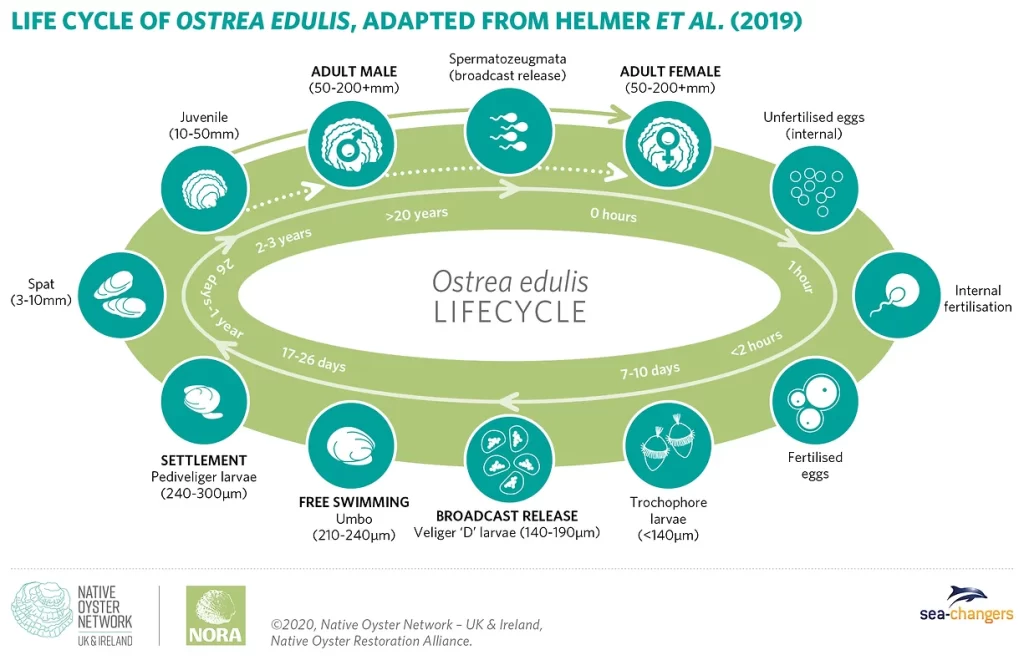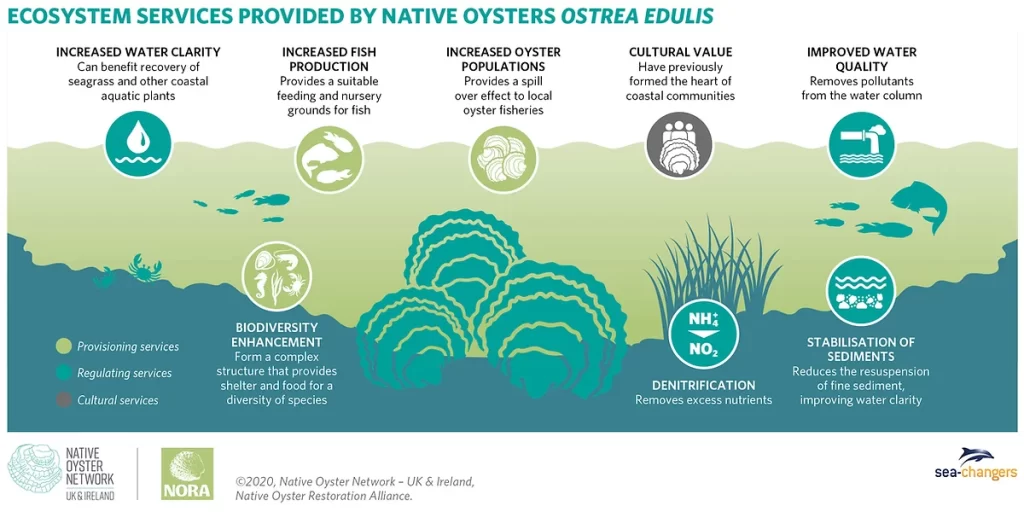The European native oyster (Ostrea edulis) is a bivalve mollusc that is typically associated with shallow, subtidal coastal and estuarine habitats. The native oyster has a rounded, rough shell with a pale green, yellow or brown colouring. The two halves of a native oysters shell are different shapes. The left shell is deeply concave and fixed to the substratum, the right being flat with rougher edges and sitting inside the left, acting as a lid. Inner surfaces of both valves or shells are smooth and usually pearly, white or bluish-grey, often with darker blue areas. The native oyster has a typical life span of 5-10 years and grows up to 15cm in shell height.
Oysters are filter feeders, they use their valves to pump water across hair like gill structures to filter out microscopic algae and small organic particles from the surrounding water, which serve as the oyster’s food.
Native oysters have a fascinating life history trait, whereby an animal can alternate between male and female several times throughout its life, defining them as a protandrous hermaphrodite. Native oysters begin life as male, then – upon reaching sexual maturity at around two to three years of age – they spawn, following which they switch to females, capable of producing eggs. A female oyster of around 8cm in size is capable of producing 1 million larvae, while larger individuals are capable of producing as many as 2 million larvae in a single spawning event.
The number of oysters surviving to maturity can vary hugely from year to year, making it a particularly vulnerable species.

Oyster reefs
Left undisturbed, oysters will form complex reef structures, which provides habitat and refuge for a diversity of organisms, such as juvenile fish, crabs, sea snails and sponges. Native oyster reefs are formed when large numbers of living oysters and dead shells form an extensive biogenic habitat on the sea floor. Oyster reefs typically form on mixed substrate, in shallow waters less than 10 meters deep, although they have been found to depths of up to 80 meters.
Populations
During the 19th century there was a thriving native oyster industry within Chichester Harbour. In Emsworth, a small fishing village within the Harbour, it is estimated that over 3 million oysters a year came to market at the peak of the industry.
However today, it is a very different picture. In the UK and Ireland, native oyster populations have declined by 95%, and oyster reefs are among the most threatened marine habitats in Europe. Within Chichester Harbour, stock levels of native oysters have become so low in recent years that the small local native oyster fishery that remained has had to close.
The decline across Europe has been caused by a range of factors including over-fishing, pollution, disease, habitat loss, predation and invasive non-native species. Within Chichester Harbour the sex ratio is heavily skewed towards male, which indicates that they are not regularly changing sex as part of their usual life cycle. This suggests that the oysters are under significant environmental stressors, impacting on reproduction and survival of the species within the Harbour.
Why are oysters important?
Oysters provide a number of valuable services to the natural environment:
- They filter particles from the water column. A single oyster can filter up to 200 litres of seawater per day, which can significantly improve water quality and clarity.
- They remove excess nutrients from water, in particular nitrogen, which in high levels can promote harmful algal blooms, oxygen depletion, and fish mortality
- The unique three-dimensional habitats they create supports a wide number of marine creatures increasing biodiversity
- The reefs can increase fish production by providing a protective nursery ground for juveniles, that acts as a refuge from predation, provides a source of food, and helps support sustainable fisheries

Further information about native oyster and restoration projects can be found following the links below:
Native Oyster Network – Facilitating the restoration of Native Oysters across the UK and Ireland